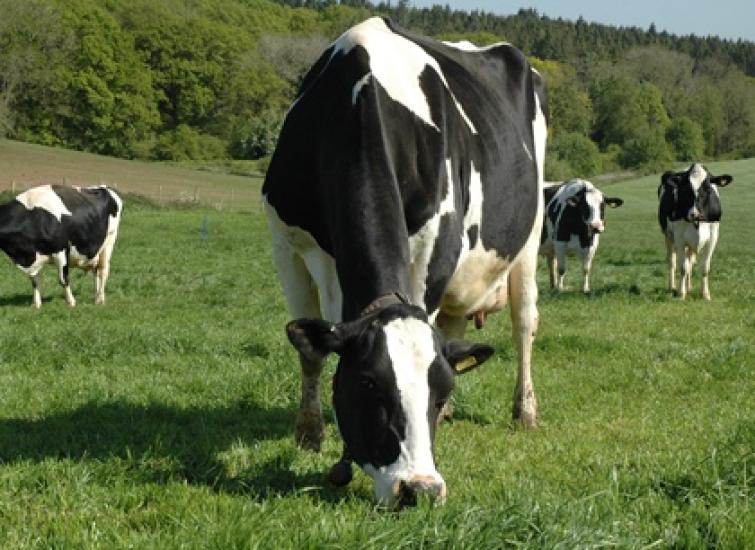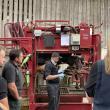Advanced Robot’s experience means they are always challenging me to get the best out of the cows, they maintain the herd’s health status whilst also improving performance.
Stepping up milk from forage with improved management
Attention to detailed grazing and forage conservation management is helping the Mason family's 10,300-litre organic herd in Herefordshire to take 40 percent of total milk from forage. Farmers Guardian reports.

Challenged to further reduce costs, Bob and Sue Mason who farm in partnership with their son, Ben, and daughter, Lucy, at Little Birch near Hereford, are confidently planning to step up to 5,000 litres from forage while continuing to maintain yield, herd health and fertility.
Grazed forage crops such as chicory and turnips, together with higher quality silage will help them to achieve their goal by filling the feed budget when quality seasonal grazing shortages due to the farm’s low summer rainfall.
Ben says: “Our objective is to run a profitable unit by maximising yield per cow from forage within the constraints of an organic system that features expensive concentrate, in particular soya - a taboo ingredient to the certification bodies. Furthermore, the Soil Association and Organic Farmers and Growers require certified dairy herds to be fed a 60% DM forage diet.
“We currently feed 2.8t concentrate per cow per lactation which includes an 18% CP specialist compound for a robotic milking system and a blend in the TMR buffer.
Blend
“We intelligently feed concentrate to complement the forage which we analyse on a monthly basis. It is the TMR blend which we would like to cut back on to 2.2t per cow by improving forage quality and the TMR presentation with a 15mm maximum grass silage and WCW crop length and homogenous mix to minimise sorting.
The grazing platform surrounding the steading is split in to 0.8ha (1.90acre) and 2ha (4.9acre) paddocks and the Masons budget on a weekly basis between 14kg and 16kg DM per 24 hours per cow, going in to a target cover of 2,500kg DM/ha and leaving a residual of 1,500kg to 1,600kg DM/ha.
In the last two years the unit’s consultant, Advanced Nutrition’s Rob Watkins has helped to develop the system which has included going from two 12 hour breaks to offering three-quarters of the daytime area in the morning and the remaining quarter in the afternoon, which makes cows more competitive and increases intakes in the morning period. Removing the fence in the early afternoon stimulates the herd to graze again, thereby further stepping up intakes and achieving target residuals.
He says “Dry matter availability changes by the day, consequently Ben is continually walking the paddocks and monitoring rate of grass growth by eye and plate metre which he uses to weekly calculate the grazing area required along with the residuals. This ensures the plant is at the correct growth stage 2 to 3 leaf stage securing maximum quality. It is all about getting every cow to eat an extra 1kg DM per day.
“Offering smaller grazing areas more frequently encourages the cows to graze more voraciously and eat more, and the practice also motivates them to visit the robotic system more frequently. The regime has enabled them to reduce the grazing area by 15% on the first round simply because the grazing is utilised more efficiently.”
Once the grazing starts to exceed 3,000kg DM/ha it’s taken out of the rotation for conservation.
The Masons operate a five-year rotation of hybrid rye grass leys with white clover making up 20 per cent of the sword. Forage intakes and summer dry matter deficits’ have been boosted by introducing to the rotation chicory and turnips which Ben says are demonstrating to be useful break crops within the summer rotation providing up to 11.5ME, 23 per cent CP and 6kg DM per cow per day.
He says: “The unit comprises sandy loam which can dry out quickly, consequently these root crops have proved to be a good insurance policy from July through to October.
“Last year we went one further and trialled under sowing the whole Crop Barley with peas, red clover, chicory and rye-grass mix to supply 12ME and 16 per cent CP. It was a very cost efficient exercise and one we’ll repeat.”
Silage
Grass silage is currently averaging 17t/ha from four cuts. In 2016 it averaged 11.9ME, 17.5 per cent CP.
“We cut at the three leaf emergence stage and always before the fourth. That is how we manage to achieve 12ME.”
The Masons agreed for the unit to go in to organic conversion in 2000.
“Dad noticed the cows found grass that hadn’t had a fertiliser application to be a lot more appetising and a decision was made there and then. In fact, I wouldn’t know how to farm conventionally,” explains Ben, who joined the family business after college 15 years ago.
“We take a very active preventative approach to herd health and management,” he says. The herd currently records 10 per cent lameness, 8 per cent mastitis incidence, no displaced abomasums, 1 per cent metritis, 1 per cent retained fetal membranes, and no milk fevers.
“We are calving at an average 24 months, cows are going on to milk for an average five lactations and their fertility is reflected in the herd’s 390-day average calving index with a 58% conception rate to first service.
“The only issue we find challenging is weed management; we’re now trying to get on top of things having just installed a slurry separator to take out dock and other weed seeds, with all the solids which will come under heat pressure during the follow up composting process.”
The Mason’s focused forage regime is not just for organic producers; there are parts of a well-run organic unit that can be introduced to every unit, says Mr Watkins.
“As an industry, we have yet to capture the full opportunity of high yields from grazed grass and their impact on the bottom line. For example, the different between M+16 litres and M+13 litres from grazed grass is worth £140 per cow per grazing season, at a 27ppl milk price.
“The average 8,000 litre herd is currently achieving just 18% from forage (Kingshay), when in fact 30 per cent to 35 per cent is an appropriate and achievable target.
“We would always aim to increase producers’ profit, so would never chase an arbitory milk from forage target; however, we are aware that its all about better grass utilisation and increasing forage quality along with better attention to TMR detail. Admittedly, managing grass and forage does require different focus than a winter housing regime simply because of the varying influencing factors. However, it can be achieved and the financial rewards are significant,” he says.
Journeying from 4,000 to 5,000 litres from forage
Grazing
- Introduce new species to swards including chicory and vigorous white clover
- Aim for more stringent targeting of covers and residuals
- Manage the grazing wedge more aggressively; resist exceeding the magic 3,000kg DM/ha target
- Select species more carefully to suit aspect and soil type – ryes for quality and early yield, and red clover and chicory for persistency.
- Reverse engineer M+ calculation (11.5ME Grass target = M + 16)
Silage
- Higher quality, reduced yield per cut, higher overall yield; target 11.5ME, 18.0 per cent CP average over five cuts
- Aim for 30 to 32 days between cuts
- Utilise nutrients more effectively using dirty water and solids strategically.
Source: Farmers Guardian, Dairy Supplement, May 19 2017 pg 133-135, FGInsight.com
〈 BACK




